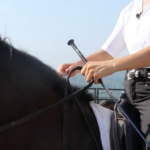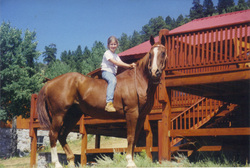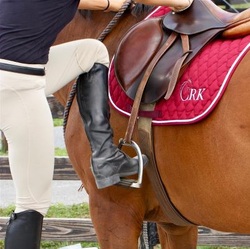When holding a whip while riding, where should you hold it?
Right at the top, in the middle of the handle, or even further down? What’s the best way to switch your whip from one hand to the other?
If you’ve ever felt a bit awkward riding with a whip, you’ll appreciate the two simple tips I’m going to explain in this week’s video.
Used correctly, a whip can be used to give aids and direction to the horse – for forward movement, turning, or stepping under with the hind legs. A correctly used aid from a whip is less aversive to the horse than thumping or squeezing incessantly with the rider’s legs.
However, as riders, we do need to be able to carry and move the whip correctly, or it won’t be effective when we use it.
The answer for where to hold a whip depends on the balance point of the whip, but most people make the mistake of holding it too close to the top, forcing them to tightly close their hand to grip the whip, with the end of the whip moving all around and making using the whip effectively almost impossible.
A similar problem then comes when needing to switch the whip from one hand to the other, Many riders find this awkward and distracting, but there is a simple technique, that – with a little practice – makes switching the whip simple and easy.
Click play below to watch the video and learn these two tips to improve your whip handling.














42 Responses
Hi Callie!
Great video as always. I will definitely be practicing this! I wanted to ask something that is pretty non-related. My horse Rocha is a very forward horse. Her previous owner must’ve only had her go fast and hardly anything slower because as soon as she starts to trot (I’m trying to teach her to go at a more slow, relaxed pace) she immediately wants to break into a fast canter. I only ride her bitless/in a rope halter since she absolutely hates bits (previous owner must’ve been very hard handed) and I always feel like I begin to lose control as soon as I want her to go any faster than a walk. How can I regain control and teach her to be more slow and relaxed? Thanks!
Hi Elise! It sounds like a safer, better place to start working with Rocha would be from on the ground first so that she understands the cues that you are looking for her to respond to. Have you had her teeth or mouth looked at?
-Julia Burdy, CRK Training Community Manager
Now that was easy and helpful.
Cool! And I thought I was just uncoordinated!
Hi Callie
Thanks- this is a really useful video.
I have been starting to work a little on the Travers (just baby steps). let’s say I am going to the right. When I try and use my whip to ask for the hindquarters to move towards the inside, I find that my outside hand goes back (with the whip) and the angle of the horse’s head changes of course towards the outside, which means that I end up in counter bend. It will probably sort itself out with practice but any tips would be welcome. Thank you
Corinne, have you tried pairing the cue with the whip with your leg so that you can try to get the same action with out the whip?
-Julia Burdy, CRK Training Community Manager
Yes i have but I find i need the whip as he is still learning (as am I). What do you think of trying a longer whip? What does the length of the dressage whip relate to generally? Thanks
Corinne, you could definitely try a longer whip – as long as it is comfortable for you to carry! The longer whips are easier to tap with in a rhythmic way.
-Julia Burdy, CRK Training Community Manager
Great tips — both the holding of the whip and the transfer. Thanks…
Great video Callie, I’ve been wondering exactly how to do this over the last week! Thanks
Sounds like this video came at a perfect time for you Lisa!
-Julia Burdy, CRK Training Community Manager
Another great video! Love your attention to detail. Simple things do make a difference. This is the first time I’ve heard it as a “rolling” action. All instructors I’ve had so far have only said “now switch your whip” and never explained exactly how, so I just winged it. We were probably concentrating on other important things like changing diagonals and other aids to get through the turn, but not knowing how to handle the whip left me feeling awkward. Now that I’ve improved balance and turning aids I’m looking forward to even smoother turns with this movement. Thank you, Callie!
Glad this video will be helpful for you in your lessons!
-Julia Burdy, CRK Training Community Manager
This is an Ah-Ha! I would never have thought of taking the whip overhand. Thank you for this tip.
Finding the balance point of the whip is interesting. My instructor instructs that I should keep a thumb length of the whip above the hand, which is a little short for the dressage whip. I use a 27″ whip and the thumb length idea works well. What is the correct length for a riding whip/crop? The riding bats seem a little short and the dressage whips seem very long.
Hi Carol, the size of the whip that Callie usually prefers is around 36″ – too long and they can be difficult to handle in the saddle and if they are too short they won’t work as well for the ‘tapping’!
-Julia Burdy, CRK Training Community Manager
Excellent tips. Thank you so much!
I would really like a vidoe on body protectors, air hit vests and any other safety equipement (helmets for me are a must, despite the Queen of England and many great Portuguse riders seen withuot one). I still hesitate re the usefulness of body protectors : the ones I tried on today are really heavy, and the air hit vest although light still carries a heavy gaz can in it, and more specifically neither protect shoulders, arms, legs, feet. I am not noticing either you or Wendy wearing protectors but maybe you do except in videos., Certainly when I was riding as a child in Ireland no one wore them (when did they get invented?). Do you have strong views on them? Could you do a video about this? Thanks in advance.
PS This was great re whip. Just gone and bought my own whip now and will practise the overhand change over!!
Fiona,
We always challenge our skills as riders. Am I right? In the arena or on the trail, the unexpected happens. After 5 falls in 3 years, 2 of them this summer in the space of 5 weeks. I will not ride English saddle without my Tipperary Ride Lite. It is super comfy and adjustable. https://www.doversaddlery.com/tipperary-ride-lite-protective-riding-vest/p/X1-40235/
Fiona, thanks for this suggestion!
-Julia Burdy, CRK Training Community Manager
Thank you for this great demonstration. I need practice until it becomes permanent.
Absolutely Kaori, practice makes permanent 🙂
-Julia Burdy, CRK Training Community Manager
Thank you Callie. That was very helpful. Whips can be so awkward. I’ll have to try this on the ground as my horse is in rehab.
Hope Jubilee is doing alright Jill!
-Julia Burdy, CRK Training Community Manager
Excellent tips regarding the whip! Always enjoy your helpful videos. Keep up the great work!
Thank you Laurie!
-Julia Burdy, CRK Training Community Manager
Thank you,very helpful. It was awkward for me holding through rains and the whip.
Awesome Peggy, glad to hear that you enjoyed this video and found it helpful!
-Julia Burdy, CRK Training Community Manager
Thank you Callie, very helpful. Speaking of the whip, I struggle with keeping my wrists straight when holding the whip, any tips on how to correct that? Much appreciated, I learn so much from these blogs!
Hi Leslie, if you click here you can read one of Wendy Murdoch’s Murdoch Minutes on keeping hands steadier and straighter.
-Julia Burdy, CRK Training Community Manager
Thank you Callie! I’m transitioning from Western to Dressage and am VERY unwieldy with a whip. Your video made me realise I was overthinking it all and making a hard job of it. Can’t wait for the rain to stop and go and practise my ‘drum majorette’ whip exercises. Thank you again!!!
Pat – I love that ‘drum majorette’ whip exercises!! Happy practicing 🙂
-Julia Burdy, CRK Training Community Manager
Thanks for the video. Could you do a video on how to apply the whip as an aid for asking for forward motion? If I use the whip on the croup of my horse, I get heads up, hollow back – not what I am looking for. Previous owner used the whip heavily and I am having to use my legs which is causing him to be dead sided from asking too much. Thanks Dawn
Hi Dawn! You can click here to watch a video on how to get forward movement when using the whip. It also doesn’t hurt to mention that you may want to have his saddle fit evaluated – sometimes that can cause some reluctance to forward movement!
-Julia, CRK Training Community Manager
I appreciate your taking the time to explain this. I was never taught about the balance point and just grab it with my hand. Would have liked to see you riding with it as I’m a bit of a beginner. But thanks.
Susan, you can watch the proper way to use the whip for forward movement as Callie demonstrates in the this How to Ride a Lazy Horse video.
Hope this helps!
-Julia Burdy, CRK Training Community Manager
I have seen riders do this from afar & have always thought it was some kind of magic trick. Know I know their secret. One request, is it possible to get a close up of the step where you transfer the rein into the whip hand? That has me stumped.
Hi Terry, if you go down to the settings wheel on this video and click on speed you can slow the video down to watch that clip in slow motion!
-Julia Burdy, CRK Training Community Manager
Hi Callie & Julia,
Something to practice for sure – I’m sure I will end up quite tangled !! Recently I have been given conflicting information on switching the whip over. My usual instructor has always taught me to have the whip on the ‘inside’ but another instructor says not to change it over at all. I would appreciate your thoughts.
Lisa, I find it better to be able to switch to help encourage the inside leg to step under on the inside of the bend!
-Julia Burdy, CRK Training Community Manager
Thank you so much for these videos. I now have to practice these helpful tips. You relay the information in terms anyone can understand. I didn’t grow up around horses and trainers; so some terms used by trainers were “greek” to me. Can’t wait to practice the whip holding and switvhing (which seemed so awkward they way I was doing it),
Hi Susan, thanks for your comment and I’m glad we could help simplify it for you 🙂
-Julia Burdy, CRK Training Community Manager